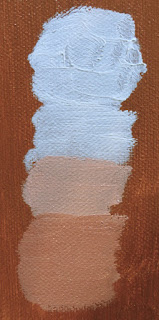Flemish White
I've had my tube of Flemish White since Spring 2014 and it's not one I use extensively. Made from tribasic lead sulfate and barite Flemish White is the warmest and most opaque of the Rublev Lead Whites. I found that it yellows more than the others. Take a look at the dried paint on this tube compared to fresh paint below.
Here you can see the opacity of Flemish White. It's not as opaque as Titanium White though.
I've noticed that it yellows within a month of drying. I had that unpleasant experience after I laid in thick highlights on one of my paintings last year. Later on I tried putting Lead White # 2 over it and that helped a little. Still I wasn't happy about the color change.
I have no idea why Flemish White yellows like that. It's binder is walnut oil which does not yellow like linseed oil as it ages. The yellowing could be a characteristic of the tribasic lead sulfate and barite combination. In comparison Lead White # 2 is made from basic lead carbonate and I have not experienced any yellowing thus far.
Straight out of the tube Flemish White feels a bit buttery, is shorter than Lead White # 2 but peaks up as shown here. It's feel under the brush is smooth with no drag. Lead White # 2 has a bit more drag to it, somewhat like honey.
I also mentioned that Flemish White is warmer than the other lead whites. This is especially noticeable when I mixed it with Venetian Red. In addition it's greater opacity created stronger flesh tints that did not sink into the orange ochre underneath.
Some artists like Flemish White and it's a staple on their palettes. However I do not find it as useful as Rublev's other lead whites and I've mostly used it for underpainting. For general painting it's tendency to yellow does not make it appealing to me. Overall it's strengths lie in it's opacity and warmth and this may be useful in some way if the yellowing is disregarded.





No comments:
Post a Comment